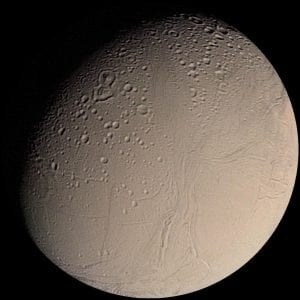Analysis of measurements taken by NASA’s Cassini space probe suggests a global ocean beneath the surface of Saturn’s moon Enceladus (1).
Enceladus, a world covered by a thick crust of ice, has long piqued NASA scientists’ interest because of the unusual liquid water geysers surrounding its south pole. These water jets had previously been attributed to a small subterranean sea surrounding the region (1). However, new research published in the journal Icarus finds that this small sea is actually a vast global ocean (1).
As moons orbit their parent planet, they go through cycles of slower and faster rotation because their orbits are not perfectly circular. The surface of the moon needs time to “catch up” to the core, resulting in an apparent wobble known as libration.
Typically, moons librate very slightly because solid rock is too rigid to allow for much internal twisting. However, analysis of images received from Cassini shows that Enceladus’s surface wobbles 400 percent more than it should if it were solid all the way through (1).
To explain Enceladus’s extreme surface wobble, these scientists created and analyzed several mathematical models of hypothesized internal structures. They found that Enceladus’s wobble matches the model of a moon whose crust is detached from its core, separated by a liquid layer—one that contains a global ocean (1).
Enceladus’s unexpected abundance of water is a noteworthy discovery, since the presence of liquid water is presently our best predictor as to whether or not an extraterrestrial body could harbor alien life. These new findings put Enceladus on level standing with Jupiter’s moon Europa, another icy world with a hypothesized subterranean ocean that was previously hailed as the best candidate for the discovery of extraterrestrial life within our solar system (2,3). Currently, the team is investigating the possibility of hydrothermal activity on Enceladus’s ocean floor. If these findings prove true, Enceladus may harbor a deep-ocean biome nearly identical to those found on Earth (3).
References:
1. P.C. Thomas, R. Tajeddine, M.S. Tiscareno, J.A. Burns, J. Joseph, T.J. Loredo, P. Helfenstein, C. Porco. Enceladus’s measured physical libration requires a global subsurface ocean. Icarus, 2015; DOI: 10.1016/j.icarus.2015.08.037
2. Nancy Atkinson (2009). “Europa Capable of Supporting Life, Scientist Says”. Universe Today. Retrieved September 20, 2015 from www.universetoday.com/42303/europa-capable-of-supporting-life-scientist-says/
3. NASA/Jet Propulsion Laboratory. (2015, September 15). Cassini finds global ocean in Saturn’s moon Enceladus. ScienceDaily. Retrieved September 20, 2015 from www.sciencedaily.com/releases/2015/09/150915155309.htm


Leave a Reply